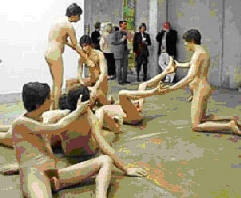
intelligent agent vol. 4 no. 1
free radical
the work of art in the age of techno-somaticism: gregory little
download pdf
free radical
the work of art in the age of techno-somaticism: gregory little
download pdf
 |
intelligent agent vol. 4 no. 1
free radical the work of art in the age of techno-somaticism: gregory little download pdf |
The
Work of Art in the
Age of Techno-Somaticism: immersed in the body without organs (A
Prelude to the Embodiment thread in IA 4.2)
|
|
Free
Radical by Gregory Little
Part
One: the age of somaticism
"Perhaps
one could also enter a plea on behalf of Narcissus (or at least invoke
extenuating circumstances in his favor). In a world in which technological
mastery has made such rapid strides, can one not understand that the desire
to feel -- and to feel oneself -- should arise as a compensation,
necessary, even in its excesses, to our psychic survival?"
|
 Charles Ray "Oh Charlie, Charlie, Charlie" |
Paul
Valéry's prediction that western culture will enter an age of somaticism
has come to pass. Indeed, the body is the primary instrument used to determine
our well-being, safety, and destiny. Acting upon the body, via cosmetics,
genetics, or genocide, is the path of our panaceas. However, Valéry
did not foresee the emergent relationship between technology and somaticism.
In our current condition, the somatic -- that is, everything relating
to the body -- is positioned in counterpoint to rapid developments in
networked, ubiquitous, and viractual technologies. While much of technological
development seems targeted at the erasure of the corporeal; the isolated
somatic impulse, largely through the strategies of the feminist, ecological,
and civil rights movements, refuses to disappear into technoculture. The
mortal, vulnerable body patiently throws
itself across the path of the wheels of techno-determinism. The co-existence
of simultaneous and obsessive impulses -- to outstrip the body and to
reclaim our body -- has created a heightened hybrid condition not far
from an official religion: the condition of techno-somaticism.
As the routines of the technological settle into the post-modern psyche, the flow of sentient information has found alternative mappings to the traditional Freudian paths. In the transition from the psycho-somatic to the techno-somatic, sensory loops of psychic impulses from mind to body to mind have been interrupted and redirected by telematic couplings, toward a variety of internal and external outcomes. In The Question Concerning Technology, Martin Heidegger defined technë as nature in standing reserve [Bestand], and further defines nature as a stockpile of raw materials awaiting instruction for technological production. Heidegger overlooked the simple fact that the body itself and we as humans -- the very instigators and benefactors of technological production -- are part of Bestand, inseparable from nature in our material existence, our mortality, and our origins; and that we augment technological production as part of the labor workforce. Therefore the body itself awaits initiation, and is at risk as a raw material of complete consumption. Subjectivity is in jeopardy as technë does not seek a "bringing forth in the sense of poiësis." To Heidegger, the earth revealed itself as a coal mining district, the soil as a mineral deposit; and in the age of techno-somaticism, the body reveals itself as a synapse, a connecting nexus between modes of production, informing technological artifacts, reducing human subjectivity to catalyst and recall, to 'users' and 'content providers.' The level of our fears related to the potential for the loss of the body's autonomy, sentience, and material existence in this cyber-somatic loop is in direct proportion to increases in the ubiquity of technological determinism and the scale of accumulation of technological artifacts. This loss has instigated a sweeping compensatory gesture, manifest as a popular, cultural, theoretical, and economic obsession with issues rooted in a variety of definitions of the body. The cultural deluge of phrase bites like 'body image,' 'body consciousness,' 'body language,' 'body knowledge,' 'body adornment,' 'getting in touch with our bodies,' 'our bodies -- ourselves,' 'perfect bodies,' our 'lost bodies,' 'information bodies,' 'cinematic bodies,' 'data bodies,' 'obsolete bodies,' 'techno-bodies,' 'nostalgia for the body,' 'the amputated body,' and 'beating the meat' characterize our narcissistic obsessions with the exigencies of our techno-somatic flesh. Fixing the wet and slippery location of the 'body' within these techno-hegemonic, telematic matrixes is a bit like nailing jelly to a wall, and leads to speculation about who, where, and how many bodies are I / we? As an artist interested in the realization of philosophical and humanist methodologies through immersive, interactive technologies, I am especially interested in spatial models of somaticism that facilitate imaginings. In part two of this essay, I will discuss a synthesis of strategies, 'sexts' and 'texticles' that I have brought to bear on my ongoing immersive virtual environment, The Body w/o Organs. |
|